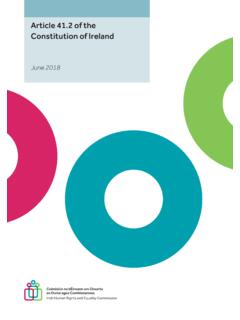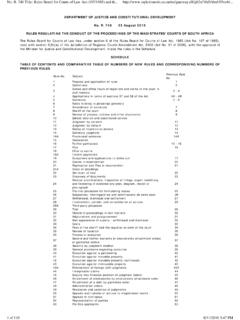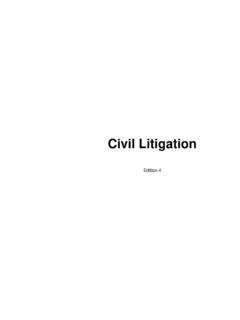Transcription of Human Rights Explained - IHREC
1 Human RightsExplainedGuide to Human Rights LawHuman RightsExplainedGuide to Human Rights LawFirst published in September 2015byIrish Human Rights and Equality Commission16-22 Green Street, Dublin 7, D07 2015 Irish Human Rights and Equality CommissionThe Irish Human Rights and Equality Commission ( IHREC ) was established under statute on 1 November 2014 as an independent statutory body to protect and promote Human Rights and equality in Ireland. It promotes a culture of respect for Human Rights , equality and intercultural understanding and works to eliminate Human Rights abuses and | 1.
2 Introduction5 | 2. What are Human Rights ?6 | Introduction6 | What are Human Rights ? 7 | Who are Human Rights for? 7 | Where are Human Rights found?7 | Who is Responsible for Respecting, Protecting and Fulfilling Human Rights ?8 | The Human Rights Framework in Ireland9 | 3. Human Rights and Ireland10 | Introduction10 | The Irish Constitution11 | European Convention on Human Rights Act 2003 13 | 4. Human Rights and Europe14 | Introduction14 | What is the European Human Rights System? 14 | Council of Europe14 | European Convention on Human Rights 16 | European Court of Human Rights16 | Cases involving Ireland20 | European Convention on Human Rights Act, 2003 22 | Positive Obligations22 | Council of Europe Commissioner for Human Rights23 | European Union 23 | Charter of Fundamental Rights24 | When the Charter applies24 | Fundamental Rights Agency25 | 5.
3 Human Rights and the International System26 | Introduction26 | What is the international Human Rights system?26 | What is the United Nations?27 | The United Nations Treaty System28 | United Nations Treaty Monitoring29 | The Universal Periodic Review 31 | 6. The role of the Irish Human Rights and Equality Commission33 | Legal Assistance33 | Information and support 1 |1. Introduction| 2 IntroductionThe Irish Human Rights and Equality Commission ( IHREC ) was established on 1 November 2014, as an independent statutory body, to protect and promote Human Rights and equality in Ireland.
4 We aim to build a culture of respect for Human Rights , equality and intercultural understanding in Irish society. One of the ways of doing this is promoting awareness and understanding of Human Rights . Everyone has Human Rights that should be protected. People can only claim their Rights if they know about them. The aim of this Human Rights Guide is to give a brief overview of Human Rights . It begins by explaining what Human Rights are and the role of Ireland in protecting and upholding respect for them.
5 The Human Rights Explained here include the protections set out in the Irish Constitution, the European Convention on Human Rights and the standards in the many international conventions and treaties which Ireland has committed to respect, protect and IHREC has a role to ensure that Human Rights and equality protections are to the fore in law, policy and practice. Therefore we review legislation, public policy and practice and advise the Government of any changes that are required to make sure Human Rights standards are being met.
6 To vindicate individual Human Rights , the IHREC may grant legal assistance to individuals seeking to take legal proceedings involving Human Rights . This booklet only gives information it is not a legal document. 3 |TermIn other an obligation, or duty to / TreatyA formal international forceWhen a convention or treaty is in force in a state, it means that the state has ratified the instrument and its provisions now apply to the amendment or addition to a treaty or term provision is often used when referring to the content of particular articles within a / RatificationAn act by which a State signifies an agreement to be legally bound by the terms of a particular convention or Party / Party toA State party or a party to a Convention/Treaty is a country that has ratified that particular treaty.
7 And is legally bound by its provisions.| 4 5 |2. What are Human Rights ?| 6 What are Human Rights ?IntroductionThis section sets out briefly what Human Rights are, where they have come from and who is responsible for upholding are Human Rights ? Human Rights are the basic Rights and freedoms that belong to everyone. International law, including treaties, contain the provisions which give Human Rights legal effect. Ideas about Human Rights have evolved over many centuries and the formal protection of these Rights gained strong support after World War II.
8 In order to protect future generations from a repeat of gross Human Rights abuses in particular the Holocaust the United Nations adopted the Universal Declaration of Human Rights in 1948. The Declaration sets out for the first time the Human Rights and fundamental freedoms shared by all Human beings without discrimination of any Rights are: Universally agreed basic standards that aim to ensure that every person is treated with dignity and respect; Interdependent and indivisible, meaning that Rights are linked and not protecting one right may impact on another.
9 For example, failure to protect the right to health may affect the right to life; Inherent, meaning they belong to all people without discrimination. The principle of non-discrimination is at the centre of Human Rights and features in all of the Human Rights treaties; and Usually set out in law, through international or regional treaties, or national legislation where they form a legal statement of universally 7 |accepted principles of how the state should treat its citizens and other people living within its Rights include: Civil and Political Rights , such as the right to life, the right to a fair trial and the right not to be subjected to torture.
10 And Economic, Social and Cultural Rights , such as the right to work, to join a trade union, to health, to education, and to an adequate standard of groups are protected in specific treaties such as women, children, people with disabilities, minorities, and are Human Rights for? Human Rights are for everyone. Central to the concept of Human Rights is respect for the life and dignity of every person. Where are Human Rights found? Human Rights are usually set out in law. They are found in international (mainly United Nations), regional (European) treaties, or in national constitutions and national is Responsible for Respecting, Protecting and Fulfilling Human Rights ?













